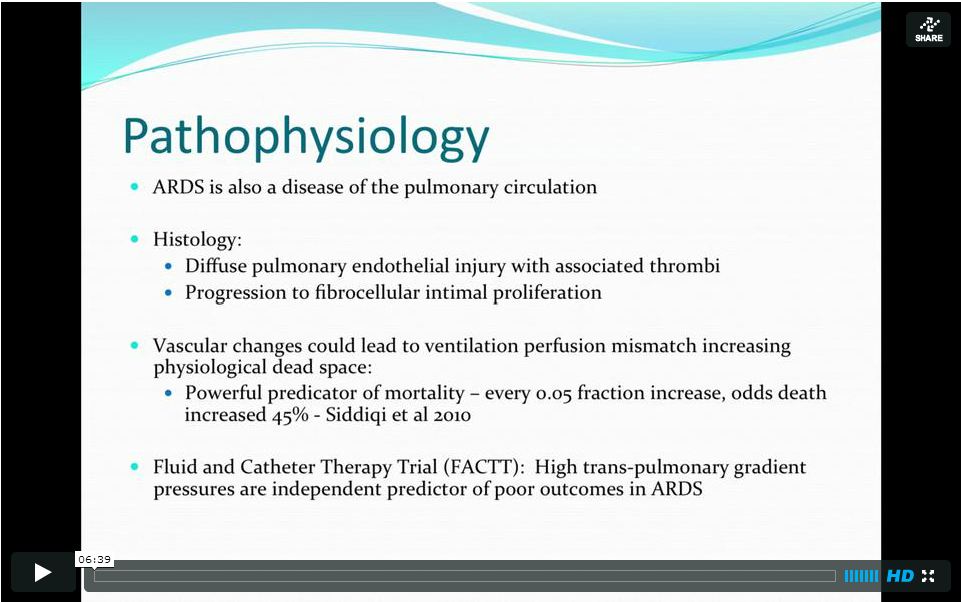Acute respiratory distress syndrome (ARDS) is a rapidly progressive disorder that initially manifests as dyspnea, tachypnea, and hypoxemia, then quickly evolves into respiratory failure. Acute Respiratory Distress Syndrome, or ARDS, is a condition that causes fluid to leak into your lungs, blocking oxygen from getting to your organs. It is serious, sometimes lifethreatening, and. Mutations of SPB and SPC cause acute respiratory distress syndrome and chronic lung disease that may be related to the intracellular accumulation of injurious proteins, extracellular deficiency of bioactive surfactant peptides, or both. Acute respiratory distress syndrome (ARDS) is a lifethreatening lung condition that prevents enough oxygen from getting to the lungs and into the blood. Infants can also have respiratory distress syndrome. Acute respiratory distress syndrome. Acute respiratory distress syndrome (ARDS) is the most severe form of acute lung injury, characterized by acute pulmonary infiltrates, abnormal respiratory system compliance, and moderate to severe hypoxemia. Acute respiratory distress syndrome (ARDS) is a type of severe, acute lung dysfunction affecting all or most of both lungs that occurs as a result of illness or injury. Although it is sometimes called adult respiratory distress syndrome, it may also affect children. The efficacy of venovenous extracorporeal membrane oxygenation (ECMO) in patients with severe acute respiratory distress syndrome (ARDS) remains controversial. The term acute respiratory distress syndrome was used instead of adult respiratory distress syndrome because the syndrome occurs in both adults and children. ARDS was recognized as the most severe form of acute lung injury (ALI), a form of diffuse alveolar injury. Acute respiratory distress syndrome (ARDS) is a noncardiogenic pulmonary oedema and diffuse lung inflammation syndrome that often complicates critical illness. Acute respiratory distress syndrome (ARDS) is a severe lung condition. It occurs when fluid fills up the air sacs in your lungs. Too much fluid in your lungs can lower the amount of oxygen or. Acute respiratory distress syndrome definition is respiratory failure of sudden onset in adults or children that follows injury to the endothelium of the lung (as in sepsis, chest trauma, massive blood transfusion, aspiration of the gastric contents, or pneumonia) and results in the accumulation of proteinrich fluid and the collapse of. Acute Respiratory Distress Syndrome affects 200, 00 people in the US each year. About half will die from it, many others will have lifelong complications. Acute respiratory distress syndrome (ARDS) occurs when fluid builds up in the tiny, elastic air sacs (alveoli) in your lungs. The fluid keeps your lungs from filling with enough air, which means less oxygen reaches your bloodstream. Acute respiratory distress syndrome often has to be differentiated from congestive heart failure, which usually has signs of fluid overload, and from pneumonia. Treatment of acute respira Acute respiratory distress syndrome (ARDS) is a lifethreatening lung condition that prevents enough oxygen from getting to the lungs and into the blood. [1 People who develop ARDS often are very ill with another disease or have major injuries. [2 Acute respiratory distress syndrome of ARDS is een ernstige longaandoening die ontstaat ten gevolge van een ernstige ziekte van de longen zelf (bijvoorbeeld een longontsteking) of een ziekte elders in het lichaam. ARDS ontstaat doordat de primaire ziekte op nog onbekende wijze een heftige ontstekingsreactie in de longen veroorzaakt. Acute respiratory distress syndrome (ARDS) is a common and devastating condition which can affect all adult patients eg, medical, surgical and obstetric patients. It occurs when noncardiogenic pulmonary oedema (secondary to acute damage to the alveoli) leads to acute respiratory failure. Respiratory distress syndrome (RDS) is a breathing disorder that affects newborns. RDS rarely occurs in fullterm infants. The disorder is more common in premature infants born about 6. The acute respiratory distress syndrome (ARDS) is an important cause of acute respiratory failure that is often associated with multiple organ failure. Several clinical disorders can precipitate ARDS, including pneumonia, sepsis, aspiration of gastric contents, and major trauma. ARDS, or acute respiratory distress syndrome, is a lung condition that leads to low oxygen levels in the blood. This is because your body's organs, such as the kidneys and brain, need oxygenrich blood to work properly. Acute respiratory distress syndrome (ARDS) is a noncardiogenic pulmonary edema and diffuse lung inflammation syndrome that often complicates critical illness. The diagnosis of ARDS is based on fulfilling 3 criteria: Acute onset (within 1 week). Acute respiratory distress syndrome (ARDS) is a lifethreatening condition where the lungs can't provide the body's vital organs with enough oxygen. It's usually a complication of. Acute Respiratory Distress Syndrome Network, Brower RG, Matthay MA, et al. Ventilation with lower tidal volumes as compared with traditional tidal volumes for acute lung injury and the acute respiratory distress syndrome. Acute respiratory distress syndrome (ARDS) ARDS or shocklung, is a lifethreatening condition in which the lungs become severely inflamed. It can be triggered by an infection such as pneumonia. A review of the pathophysiology of acute respiratory distress syndrome, or ARDS. Category Science Technology; License Creative Commons Attribution license (reuse allowed) Neonatal respiratory distress syndrome (RDS) is a problem often seen in premature babies. The condition makes it hard for the baby to breathe. Neonatal RDS occurs in infants whose lungs have not yet fully developed. The disease is mainly caused by a lack of a slippery substance in the lungs called surfactant. A, Cumulative frequency distribution of tidal volume was similar in patients in each severity category, with 65 of patients with acute respiratory distress syndrome (ARDS) receiving a tidal volume of 8 mLkg of predicted body weight or less. Acute respiratory distress syndrome was first described in and has become a defining condition in critical care. It is an acute inflammatory lung injury, often caused by infection, which increases lung microvascular permeability, resulting in hypoxaemic respiratory failure. Acute Respiratory Distress Syndrome (ARDS) is an acute diffuse, inflammatory lung injury, leading to increased pulmonary vascular permeability, increased lung weight, and loss of aerated lung tissue with hypoxemia and bilateral radiographic opacities, associated with increased venous admixture, increased physiological dead space and decreased lung compliance. Acute respiratory distress syndrome (ARDS) is a permeability pulmonary edema characterized by increased permeability of pulmonary capillary endothelial cells and alveolar epithelial cells, leading to hypoxemia that is refractory to usual oxygen therapy. What is Acute Respiratory Distress Syndrome? Acute Respiratory Distress Syndrome (ARDS) is a lifethreatening illness in which the lungs are severely inflamed. Acute respiratory distress syndrome (ARDS) is a severe inflammatory reaction of the lungs to pulmonary damage. SIRS and sepsis are the most common causes, but various other systemic or pulmonary factors such as pneumonia or aspiration can lead to ARDS. Acute respiratory distress syndrome presents as hypoxia and bilateral pulmonary infiltrates on chest imaging in the absence of heart failure sufficient to account for this clinical state. Management is largely supportive, and is focused on protective mechanical ventilation and the avoidance of fluid overload. Since its first description, the acute respiratory distress syndrome (ARDS) has been acknowledged to be a major clinical problem in respiratory medicine. From July 2015 to July 2016 almost 300 indexed articles were published on ARDS. This review summarises only eight of them as an arbitrary overview. This month marks the 50th anniversary of the first description of the condition now termed the acute respiratory distress syndrome, or ARDS. The authors of this review discuss our current. Acute respiratory distress syndrome Marco Confalonieri, Francesco Salton and Francesco Fabiano Affiliation: Pulmonology Dept, University Hospital of Cattinara, Trieste, Italy. Air pollution exposure may be associated with increased airway obstruction but not reduced lung volume until age 16. Acute respiratory distress syndrome (ARDS) is sudden and serious lung failure that can occur in people who are critically ill or have major injuries. This content does not have an English version. This content does not have an Arabic version. Acute respiratory distress syndrome is a form of noncardiogenic pulmonary oedema, due to alveolar injury secondary to an in ammatory process, that can be either pulmonary or systemic in origin. This syndrome presents as acute hypoxaemia with bilateral pulmonary in ltrates ARDS, or acute respiratory distress syndrome, is a lung condition that leads to low oxygen levels in the blood. ARDS can be life threatening because your body's organs need oxygenrich blood to work well. The acute respiratory distress syndrome (ARDS) is a major cause of acute respiratory failure. Its development leads to high rates of mortality, as well as short and longterm complications, such as physical and cognitive impairment. Acute respiratory distress syndrome (ARDS). Anteroposterior (AP) portable chest Xray film shows an endotracheal tube, left subclavian central venous catheter into the superior vena cava, and bilateral patchy opacities in mostly the middle and lower lung zones. The acute respiratory distress syndrome (ARDS) is an important cause of acute respiratory failure that is often associated with multiple organ failure. Several clinical disorders can precipitate ARDS, including pneumonia, sepsis, aspiration of gastric contents, and major trauma. Acute respiratory distress syndrome (ARDS) is a rapidly progressive disease occurring in critically ill patients. The main complication in ARDS is that fluid leaks into. acute respiratory distress syndrome (ARDS) a group of symptoms accompanying fulminant pulmonary edema and resulting in acute respiratory failure; called also shock lung, wet lung, and many other names descriptive of etiology or clinical manifestations. Many etiologic factors have been associated with ARDS, including shock, fat embolism, fluid. 15 Acute Respiratory Distress Syndrome 2 Acute respiratory distress syndrome (ARDS) is a condition in which the lungs suffer severe widespread injury, interfering with their ability to take up oxygen. Acute Respiratory Distress Syndrome (ARDS) for USMLE Step1 and USMLE Step 2 Duration: 28: 04. the study spot 33, 601 views.










.jpg)
